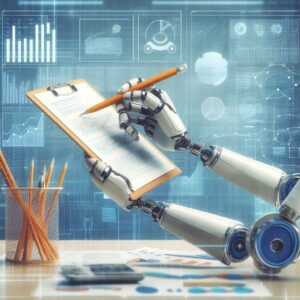Introduction
In today’s rapidly evolving business landscape, the concept of automation has taken center stage, reshaping how enterprises operate and thrive. Automation, the art of delegating tasks and processes to smart technologies and algorithms, has become more than just a buzzword; it’s an imperative for businesses looking to stay competitive in a fast-paced world. From streamlining routine workflows to revolutionizing entire industries, automation has proven itself as a game-changer that promises both efficiency and innovation.
The potential benefits of automation are vast and varied. Efficiency gains are at the forefront, with repetitive and time-consuming tasks being handled swiftly and accurately by machines. This not only frees up human resources to focus on more creative and strategic endeavors but also leads to cost reductions and enhanced productivity. Furthermore, the quality and consistency of output are greatly improved, as machines don’t suffer from the fatigue or human errors that can occasionally plague traditional workflows. These advantages make automation an attractive proposition for businesses of all sizes and across industries.
Yet, this transition towards automation is not without its challenges and ethical considerations. As we delve deeper into this article, we will explore the multifaceted nature of automation, the positive impact it can have on businesses, as well as the concerns it raises in terms of employment, security, and the responsible use of advanced technologies. Striking a balance between leveraging automation’s benefits and addressing these concerns is the core challenge for organizations today. In the following sections, we will dive into the fundamentals of automation, its economic and societal implications, and the ethical responsibilities that come with it, aiming to provide a holistic view of how automation is transforming the modern enterprise.
1: The Fundamentals of Automation
In this section, we will lay the groundwork by exploring the fundamental concepts and technologies that underpin automation. At its core, automation involves the delegation of tasks and workflows to intelligent systems and machines, streamlining processes, and reducing the need for human intervention. The key driving forces behind automation are technologies like artificial intelligence (AI), robotics, and robotic process automation (RPA). These technologies enable businesses to harness the power of automation and transform the way they operate.
Artificial intelligence, often referred to as AI, is a pivotal element in automation. It encompasses machine learning, natural language processing, and data analysis to enable machines to learn and make decisions independently. AI algorithms can analyze vast datasets, identify patterns, and adapt to changing circumstances, making them ideal for tasks that require cognitive capabilities. This allows businesses to automate decision-making processes, leading to faster and more accurate outcomes.
Robotics is another cornerstone of automation. These physical machines, whether industrial robots on the factory floor or robotic arms in laboratories, are designed to perform a wide range of tasks with precision and efficiency. They can execute repetitive physical activities, work in hazardous environments, and even collaborate with human workers. Robotics, when integrated with AI, can create a potent combination for automating complex tasks and workflows.
Robotic Process Automation (RPA) is a technology that specializes in automating rule-based and routine tasks, often within office settings. RPA solutions mimic the actions of a human operator interacting with digital systems, such as software applications and databases. By doing so, they can automate data entry, document processing, and other repetitive administrative tasks, reducing errors and speeding up these processes.
Understanding these fundamental components of automation sets the stage for exploring how businesses can harness their capabilities to drive innovation and efficiency while also navigating the challenges and ethical considerations associated with automation.
2: The Benefits of Automation
In this section, we will delve into the multitude of advantages that automation offers to businesses of all sizes and across various industries. Automation isn’t just a technological trend; it’s a strategic move that can fundamentally transform how enterprises operate and thrive.
The foremost benefit of automation is enhanced efficiency. By automating routine and repetitive tasks, businesses can achieve remarkable time savings and accuracy. This translates into increased productivity and cost reductions, enabling employees to focus on more complex and value-added activities. Consider a scenario where data entry, which was once a tedious and error-prone manual task, is now handled by automation. This not only speeds up the process but also virtually eliminates the risk of human errors, leading to cost savings and improved overall quality.
Automation also brings a new level of scalability to businesses. Whether it’s handling a surge in customer inquiries, managing inventory, or processing large datasets, automated systems can quickly adapt to fluctuations in demand. They don’t require breaks or rest, which means operations can run 24/7, offering unparalleled flexibility and responsiveness.
Furthermore, the quality and consistency of output are greatly enhanced through automation. Machines don’t experience fatigue, boredom, or stress, ensuring that tasks are performed with precision and accuracy every time. This consistency is especially crucial in industries where product quality and compliance with regulations are paramount, such as healthcare, manufacturing, and finance. Businesses can rely on automation to maintain high standards and regulatory compliance without variation.
These benefits collectively make automation an appealing prospect for businesses. However, as we’ll explore in the following sections, there are also concerns and challenges that need to be addressed when implementing automation, from potential workforce disruptions to data security and ethical considerations. Achieving a balance between harnessing the advantages of automation and addressing these concerns is a pivotal task for organizations in the modern era.
3: Concerns and Challenges
While automation offers a wealth of advantages, it also brings with it a host of concerns and challenges that businesses and society must grapple with. As we embark on this section, it’s crucial to acknowledge the complexities and nuances surrounding the automation landscape.
One of the foremost concerns pertains to the impact of automation on employment. The fear of job displacement due to automation is a legitimate one. As tasks and workflows are automated, there is a real possibility that some traditional roles may become obsolete. For workers whose livelihoods are tied to these tasks, this can be a source of significant unease. Addressing this concern requires thoughtful planning and strategies to reskill and redeploy affected workers, fostering a shift towards new roles that automation can create.
Security and data privacy are paramount concerns in the age of automation. As businesses rely more heavily on digital systems and intelligent technologies, they become increasingly vulnerable to cyber threats. The interconnected nature of automation systems means that a breach in one area can have far-reaching consequences. This raises the importance of stringent security measures, regular updates, and continuous monitoring to protect sensitive data and systems from potential threats.
Furthermore, there are ethical and moral considerations in automating certain tasks. For example, in areas like autonomous vehicles, there are complex questions surrounding the decisions AI systems make in critical situations. These ethical dilemmas encompass issues of transparency, accountability, and bias in algorithmic decision-making. Businesses must navigate these challenges while maintaining ethical standards and public trust.
Balancing the benefits of automation with these legitimate concerns is not a straightforward task. However, it is essential to address these issues comprehensively to ensure that automation is deployed responsibly and ethically. In the following sections, we will explore how businesses can navigate these challenges and take a balanced approach towards automation in the modern enterprise.
4: Ethics and Responsibility
As businesses embrace automation, it is imperative to consider the ethical dimensions and responsibilities that come with deploying intelligent technologies. This section delves into the ethical considerations and the responsibilities of organizations as they navigate the realm of automation.
One of the primary ethical considerations in automation lies in the decision-making processes performed by machines. Autonomous systems are increasingly making choices in a variety of contexts, from self-driving cars deciding how to respond in emergencies to AI systems determining loan approvals. Ensuring that these decisions align with ethical standards and societal values is a critical challenge. Transparency and accountability in algorithmic decision-making are key to building trust with stakeholders.
The issue of algorithmic bias is another critical concern. Automation systems learn from historical data, and if that data is biased, the algorithms may perpetuate or exacerbate existing biases. This can result in discriminatory outcomes, impacting individuals or groups unfairly. Recognizing and mitigating algorithmic bias is essential to ensure fairness and equity in automated decision-making.
Responsible automation also entails safeguarding data privacy. As more data is processed and analyzed by automation systems, it becomes imperative to protect the privacy of individuals and the confidentiality of sensitive information. Data breaches and violations of privacy can lead to severe consequences, including legal and reputational damage. Organizations must prioritize robust data security measures.
The responsibility for ethical automation extends beyond addressing specific concerns. Businesses need to establish guidelines and codes of conduct for the responsible use of automation technologies. This includes defining ethical boundaries, ensuring transparency in how automation is employed, and being prepared to rectify any ethical lapses.
In the final sections of this article, we will explore best practices for responsible automation and share examples of corporate policies aimed at ensuring ethical automation. It is by embracing these ethical considerations and responsibilities that businesses can harness the full potential of automation while upholding the highest ethical standards.
5: Responsible Automation
Responsible automation involves adopting best practices and strategies to ensure that automation is implemented in an ethical and effective manner. In this section, we will discuss key approaches for organizations to navigate the complexities of automation while upholding their ethical responsibilities.
- 1. Risk Assessment and Impact Analysis: Before embarking on an automation journey, businesses should conduct a comprehensive risk assessment. This involves identifying potential pitfalls, including ethical concerns, security risks, and impacts on employees. By understanding the risks, organizations can develop mitigation strategies and contingency plans.
- 2. Employee Training and Upskilling: Responsible automation involves investing in the workforce. As some roles are automated, it is essential to offer training and upskilling opportunities for employees to transition into new roles or acquire skills that complement automation. This fosters a positive and supportive work environment.
- 3. Human-Machine Collaboration: Automation should be seen as a complement to human capabilities, not a replacement. Encouraging collaboration between humans and machines can lead to better results. Humans can provide critical judgment, creativity, and empathy, while machines excel in routine, repetitive tasks.
- 4. Ethical Guidelines and Policies: Organizations should establish clear ethical guidelines and policies governing the use of automation. This includes defining limits on automation, ensuring transparency in algorithmic decision-making, and addressing bias and discrimination. Having these guidelines in place serves as a roadmap for responsible automation.
- 5. Continuous Monitoring and Adaptation: Automation is an evolving field. Continuous monitoring of systems, processes, and their ethical implications is essential. Organizations must be prepared to adapt and refine their approaches as they gain more experience with automation.
By embracing these principles of responsible automation, businesses can navigate the challenges associated with automation while upholding their ethical obligations. In the subsequent sections of this article, we will provide examples of companies that have successfully implemented responsible automation and the positive impacts it has had on their operations and workforce.
6: The Future of Automation
As we’ve explored the current landscape of automation, it’s important to consider what the future holds for this transformative technology. The horizon of automation is vast, with exciting developments that have the potential to reshape industries and business operations.
- 1. Automation in Cognitive Tasks: The future of automation will see an expansion into cognitive tasks. Machines and AI systems will become more proficient in tasks requiring reasoning, problem-solving, and understanding natural language. This will unlock new possibilities in fields like healthcare diagnosis, customer support, and legal research.
- 2. Complex Decision Automation: Automation will extend its reach into complex decision-making processes. By integrating data from various sources, machines will assist in making complex business decisions, including investment strategies, supply chain management, and even personalized marketing campaigns.
- 3. Sector-Specific Automation: Industries will witness the rise of sector-specific automation. Businesses will develop automation solutions tailored to the unique needs of their industries. For example, manufacturing will see the further integration of robotics, while healthcare will benefit from AI-powered diagnostic tools.
- 4. Automation and Empowerment: Automation will empower employees to focus on creative and strategic tasks. Rather than replacing human workers, automation will augment their capabilities, enabling them to perform more meaningful and high-impact work.
- 5. Enhanced Customer Experience: Automation will enhance the customer experience. Chatbots, virtual assistants, and automated customer support systems will provide instant and efficient service, leading to higher customer satisfaction and loyalty.
- 6. Opportunities for Early Adopters: Businesses that proactively embrace automation in a responsible and ethical manner will gain a competitive advantage. Early adopters of automation technologies will have the opportunity to lead their industries and pioneer new solutions.
In this dynamic landscape, the future belongs to organizations that leverage automation thoughtfully and adapt to emerging trends. By staying informed about the latest developments and maintaining a commitment to ethical automation, businesses can thrive in an increasingly automated world. The concluding section of this article will offer a summary of the key takeaways and emphasize the importance of finding the right balance between automation’s benefits and responsibilities.
Conclusion
In the ever-evolving landscape of business, automation has emerged as a powerful force with the potential to reshape industries and revolutionize workflows. The journey we’ve embarked upon in this article has taken us through the fundamentals of automation, its myriad benefits, the concerns and challenges it presents, the ethical considerations it entails, and strategies for responsible implementation. We’ve also glimpsed into the promising future of automation.
Automation offers businesses unparalleled advantages. Efficiency gains, scalability, and improved quality are just a few of the benefits that can lead to increased productivity and cost savings. However, alongside these advantages, concerns arise, particularly regarding employment and data security. The responsible use of automation is a moral imperative, as automation is not merely about enhancing business performance but also about ensuring that its societal and ethical implications are addressed.
Responsible automation is a multifaceted concept. It involves risk assessment, employee training, and collaboration between humans and machines. Ethical guidelines and continuous monitoring are crucial elements in achieving automation that respects human values and promotes fairness. As automation continues to evolve, its role in cognitive tasks, complex decision-making, and sector-specific applications will expand, offering new opportunities and challenges.
Early adopters of automation, who integrate it into their operations in a thoughtful and ethical manner, will lead the way in a future where automation coexists with human innovation. The key to harnessing the full potential of automation lies in finding the right balance between its advantages and responsibilities.
As we conclude our exploration of automation, it becomes clear that it is not the replacement of humans with machines that defines the future, but the collaboration and augmentation of human capabilities through intelligent technologies. By embracing responsible automation, businesses can thrive in a world where efficiency, innovation, and ethical values walk hand in hand. Automation is not just a trend; it is the transformative force that defines the modern enterprise.





